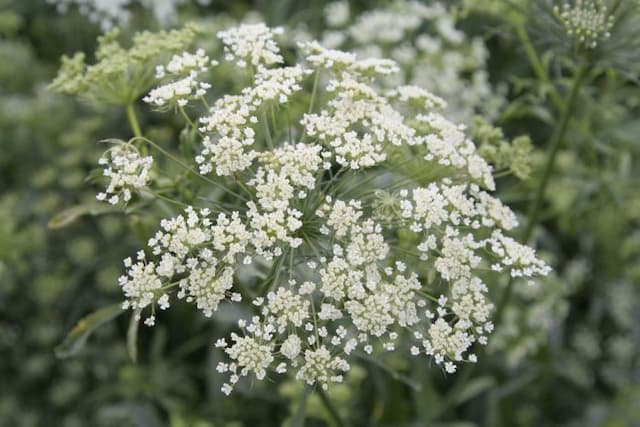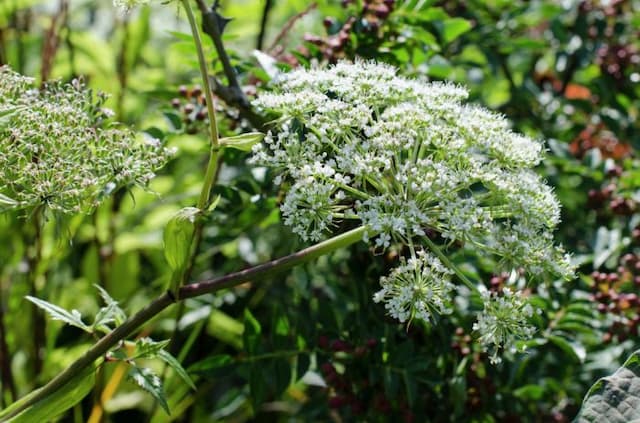Korean angelica Angelica gigas

ABOUT
Angelica gigas, commonly known as Korean angelica, is a robust perennial plant that presents a striking and imposing appearance in gardens and natural settings. The plant displays a thick, purplish, hollow stem that is upright and branched, giving it a strong architectural look. At the top of these stems, Korean angelica produces large, spherical umbels of small flowers that can be a deep, rich purple or reddish-purple hue. These showy flower clusters make the plant a favorite among gardeners looking for dramatic color and structure. Its foliage is equally attractive, consisting of large, pinnate leaves that are divided into smaller leaflets. The leaves are green, often with a hint of purple running through the veins, adding to the plant's overall lush and vibrant appearance. The edges of the leaves are serrated, providing a textured effect. The presence of these leaves complements the flowers, creating a contrasting backdrop that enhances the visual impact of the blooming umbels. Korean angelica adds to its appeal with a unique aromatic quality. The scent of the leaves and stems when crushed is notable and adds another layer of interest to this plant. Its impressive presence and the deep, rich colors it brings to the landscape make it a sought-after species for gardeners looking to add both height and drama to their plantings without delving into specific dimensions.
About this plant
 Names
NamesFamily
Apiaceae
Synonyms
Korean Angelica, Danggui, Cham Dangwi, Purple Parsnip
Common names
Angelica gmelinii, Angelica porphyrocaulis.
 Toxicity
ToxicityTo humans
Korean angelica (Angelica gigas) is not generally considered toxic to humans. However, as with many plants, individual sensitivities can vary, and some people might experience allergic reactions or contact dermatitis. It is not typically associated with severe poisoning or life-threatening symptoms when ingested. As with all plants that are not commonly used as food, it is advisable to avoid ingesting Korean angelica unless it is being used as advised by someone knowledgeable in herbal medicine, as there may still be risks of gastrointestinal upset or other adverse effects.
To pets
Korean angelica is not widely known to be toxic to pets. However, pets vary widely in their sensitivity to plants, and ingestion can potentially lead to mild gastrointestinal upset. If you suspect your pet has ingested a significant amount of Korean angelica and is showing symptoms of illness, consult your veterinarian for appropriate care. It's always prudent to prevent pets from consuming plants not intended for their diet to avoid any possible adverse reactions.
 Characteristics
CharacteristicsLife cycle
Biennials
Foliage type
Deciduous
Color of leaves
Green
Flower color
Purple
Height
4-6 feet (1.2-1.8 meters)
Spread
2-3 feet (0.6-0.9 meters)
Plant type
Herb
Hardiness zones
4
Native area
Korea
Benefits
 General Benefits
General Benefits- Attracts pollinators: Angelica gigas is attractive to bees, butterflies, and other beneficial insects, which helps pollinate surrounding plants.
- Culinary uses: The stalks and young leaves can be used in Korean cuisine, adding a unique flavor to dishes.
- Ornamental value: With its large, umbrella-shaped flowers and statuesque growth, it serves as an impressive focal point in gardens.
- Companion planting: It can be planted with other species to create biodiversity and potentially provide benefits such as pest control.
- Soil improvement: The deep roots of Angelica gigas can help improve soil structure and nutrient cycling.
- Traditional use in gardening: The plant is used for its aesthetic appeal in traditional garden design, particularly in Asian-inspired landscapes.
 Medical Properties
Medical Properties- Analgesic: Historically used in traditional medicine to help alleviate pain.
- Anti-inflammatory: May reduce inflammation and has been used in herbal remedies for this purpose.
- Menstrual health: Thought to aid in regulating menstrual cycles and alleviating symptoms of menstruation.
- Antioxidant: Contains compounds believed to have antioxidant properties, protecting cells from oxidative stress.
- Antitumor: Some compound in Angelica gigas, like decursin, have been researched for potential antitumor effects.
- Immunomodulatory: May have an effect on the immune system, potentially modulating immune responses.
- Circulatory system: Used traditionally to improve blood circulation and treat related disorders.
- Anxiolytic: May possess anxiolytic effects, helping to reduce anxiety in some traditional medicine practices.
 Air-purifying Qualities
Air-purifying QualitiesThis plant is not specifically known for air purifying qualities.
 Other Uses
Other Uses- As a dye plant: The roots of Angelica gigas can be used to obtain a natural greenish dye for coloring fabrics and yarn.
- In perfumery: The oil extracted from the plant can be used as a base note in perfumery, contributing a rich and earthy fragrance.
- Insect repellent: The strong aroma of Angelica gigas can be unpleasant to insects, making it a natural option to deter pests in the garden.
- Culinary decoration: The striking flowers and seed heads can be used as decorative elements in gourmet cuisine.
- Fishing bait: Some of the plant components, especially the roots, can be used as bait for fishing due to their pungent smell attracting certain fish species.
- Floral arrangements: The unique structure of Angelica gigas flowers makes them a dramatic addition to floral arrangements or as a standalone bouquet.
- Companion planting: Angelica gigas can attract beneficial insects to the garden, helping to naturally protect other plants from pests.
- Garden sculpture: The tall, architectural stems and umbels can be dried and used as natural sculptures in garden design.
- Biodegradable potpourri: Dried leaves and seed heads can add volume and texture to potpourri mixes.
- Traditional crafts: In some cultures, the stems have been used to make traditional ornaments or decorative items.
Interesting Facts
 Feng Shui
Feng ShuiThe Korean angelica is not used in Feng Shui practice.
 Zodiac Sign Compitability
Zodiac Sign CompitabilityThe Korean angelica is not used in astrology practice.
 Plant Symbolism
Plant Symbolism- Healing - Angelica gigas, commonly known as Korean angelica, is often associated with healing due to its medicinal properties used in traditional herbal remedies.
- Protection - Historically, the plant has been used to ward off evil spirits and negativity, symbolizing protection.
- Purification - The herb is believed to have purifying qualities, both in physical and spiritual aspects.
- Inspiration - Korean angelica is associated with inspiration, especially in the realm of creativity and intuition.
- Renewal - Its resilience and ability to grow in tough conditions make it a symbol of renewal and the ability to bounce back from adversity.
 Water
WaterKorean angelica should be watered deeply once a week, providing enough water to soak the root area. Aim to provide about 1 inch of water, which roughly translates to 0.6 gallons for an average-sized plant. During the hotter seasons or in particularly dry climates, you might need to water more frequently, ensuring the soil remains moist but not waterlogged. Adjust the watering schedule during the rainy season or cooler months, reducing the frequency to prevent overwatering. Always check the soil moisture level before watering to avoid excessive moisture, as this can lead to root rot.
 Light
LightKorean angelica prefers full sun to partial shade conditions. It thrives best when receiving at least 6 hours of direct sunlight daily, though it can tolerate some afternoon shade, especially in hotter climates. Planting Korean angelica in a spot where it's protected from the intense midday sun can help prevent leaf scorch.
 Temperature
TemperatureKorean angelica grows well in a temperature range between 60°F to 75°F, which are considered the ideal conditions for this plant. It can withstand minimum temperatures down to about 5°F, but for proper growth and development, it should not be exposed to extreme cold. Be mindful of sudden temperature drops and frosts, as they can damage the plant.
 Pruning
PruningPruning Korean angelica is necessary to remove spent flowers and encourage new growth. Prune in late fall or early spring before new growth begins. Remove any dead or damaged stems to maintain plant health and improve air circulation. Pruning can be done annually, or as needed, to shape the plant and manage its size.
 Cleaning
CleaningAs needed
 Soil
SoilKorean Angelica prefers a well-draining soil mix rich in organic matter. An ideal mix might consist of equal parts loam, peat, and sharp sand, helping to ensure adequate drainage yet retaining enough moisture for the plant's needs. The soil pH should be slightly acidic to neutral, ranging from 6.0 to 7.0 for optimal growth conditions.
 Repotting
RepottingKorean Angelica does not typically require frequent repotting as it can be grown as an annual or biennial. When grown as a perennial, it can be repotted or divided every few years to refresh the soil and accommodate growth. Overwinter indoors, and it's suggested to repot in the spring if necessary.
 Humidity & Misting
Humidity & MistingKorean Angelica thrives in an environment with moderate humidity levels. It does not require the high humidity levels that some tropical plants do but will appreciate not being placed in an overly dry location. Average room humidity should suffice, but if the air is particularly dry, occasional misting may benefit the plant.
 Suitable locations
Suitable locationsIndoor
Provide bright indirect light, keep soil moist, and ensure good air circulation.
Outdoor
Plant in partial shade, in well-draining soil, and water regularly.
Hardiness zone
4-9 USDA.
 Life cycle
Life cycleAngelica gigas, also known as Korean angelica, begins its life as a seed, which requires a period of cold stratification to break dormancy and germinate successfully. After stratification, germination typically occurs in the spring, growing into a rosette of leaves in its first year of life, remaining in this vegetative state without flowering. In its second year, the plant transitions from the rosette stage to bolting, wherein a flowering stalk elongates, and the plant develops umbel-shaped clusters of purplish or reddish flowers. Following pollination, typically by insects, Angelica gigas produces schizocarpic fruits that split into two, dispersing seeds for the next generation. The plant is monocarpic, meaning it usually dies after setting seed, completing its life cycle. However, if flowers are removed before seed set, the lifespan may extend over several years, with the plant reverting to a vegetative state and possibly flowering again in successive years.
 Propogation
PropogationPropogation time
Late summer
Propogation: Korean angelica, commonly referred to as Angelica gigas, is primarily propagated by seed. The best time to sow the seeds is in late winter or early spring as this aligns with their natural germination cycle. For successful propagation, seeds need to be fresh because their viability decreases significantly with age. A preferred method involves surface sowing the seeds onto a well-draining seed starting mix, as they require light to germinate. The flats should then be placed in a cold frame or unheated greenhouse. Germination can be irregular, taking anywhere from 30 to 120 days. It's important to keep the soil consistently moist but not waterlogged throughout this period. Once the seedlings have emerged and are large enough to handle, they can be transplanted into individual containers before eventually being moved to their final position in the garden.









